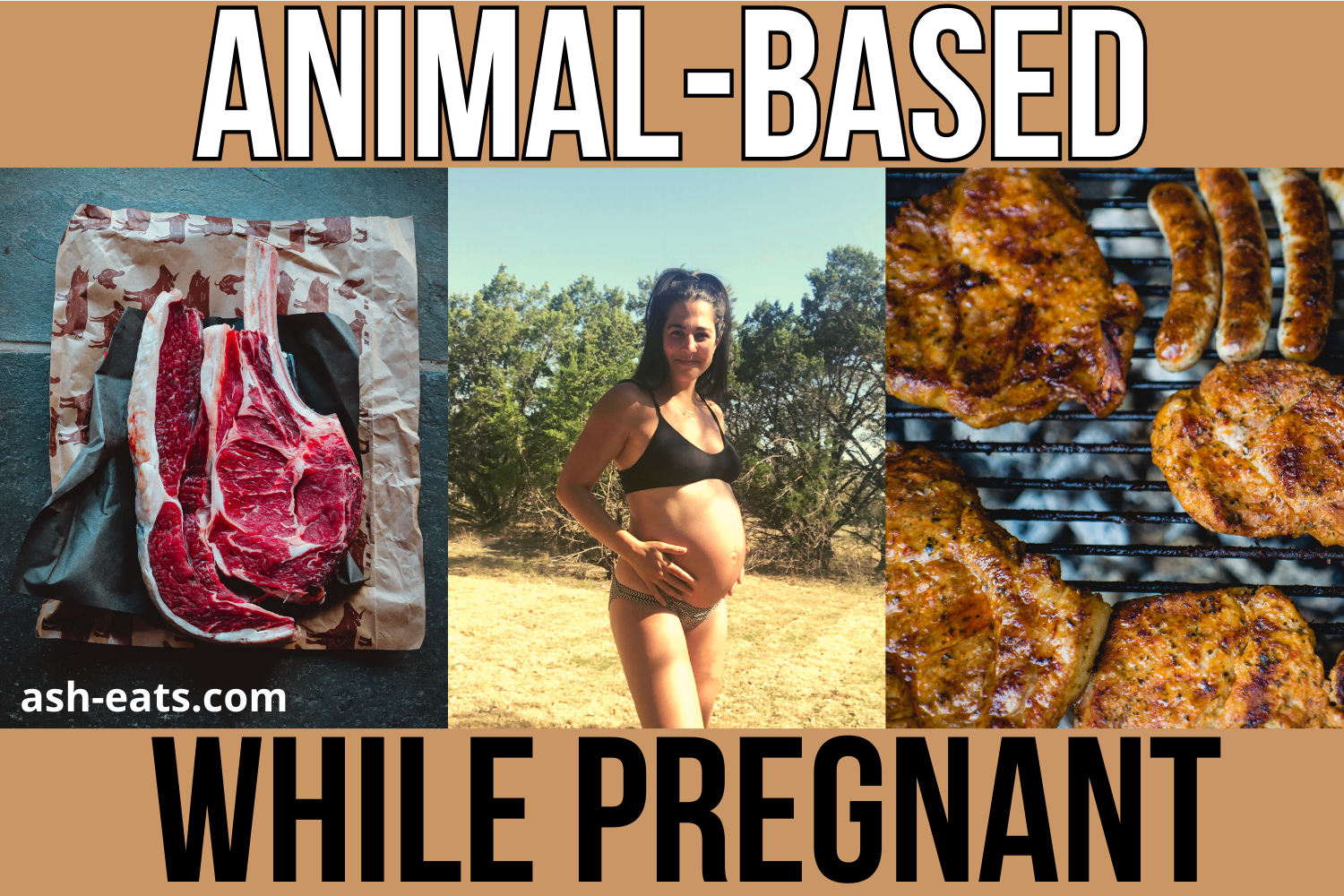
Published on April 15, 2022 by Ashley Rothstein
animal based pregnancy
Hey mama! You likely landed on this post because you’re an animal-based eater and are now pregnant. If that’s you, congratulations!
Or maybe you’re someone who just wants to learn more about an animal-based pregnancy. If that’s you, welcome!
When I first got pregnant and shared the news with my community, people seemed excited that I was following an animal-based diet while pregnant.
I received messages from people at different stages of their conception journey who warmly encouraged me to share my journey. And as I’ve continued to share what I’ve discovered and the results of my self experimentation, the enthusiasm and need for this type of information appears to be growing.
If you followed an animal-based lifestyle prior to pregnancy, you probably understand how powerful and transformative the health benefits can be.
But as soon as you get pregnant, fear tends to surface. This can lead to second guessing yourself and your choices, which partly stems from conditioning.
When it comes to pregnancy, the conditioning from conventional medicine is thick and engrained. Don’t drink raw milk or eat raw cheese. Minimize fatty meats. Reduce salt if you have swelling. Limit your food intake if you’re gaining weight. Take a prenatal vitamin. You need XYZ test or intervention to have a healthy pregnancy. The list goes on.
During my pregnancy, I did my best to not allow myself to become influenced by the forces outside of me, instead going within to determine what was right.
I kept things aligned with the methods/philosophies of our ancestors as much as possible by following an animal-based diet heavy in raw dairy, taking organs (and other natural supplements) in place of a prenatal vitamin, minimizing prenatal testing, following a gut instinct to switch providers at 30 weeks pregnant, adopting an autonomous prenatal care model, physically prepping my body for labor with foods like dates and red raspberry leaf tea, and using tools such as hypnotherapy, yoga, books, and music to prepare mentally, emotionally, and spiritually.
I have had a kick-ass pregnancy so far with minimal symptoms, and I owe a large part of that to the above-mentioned things, and ultimately, following my intuition to keep things as minimal and natural as possible.
Something else I learned is that the majority of pregnancy ailments – at least according to my n=1 experience – can be significantly reduced or even eliminated entirely via diet, proper supplementation, and/or by other natural means. I experienced a few bouts of things like constipation/hemorrhoids, fatigue, insomnia, and even one panic attack – all of which I was able to improve or resolve naturally and quickly.
I share about all of the above (and more) in this post. Every body and every pregnancy is different, but I hope you are able to find parallels between my experience and your experience, and in result, are able to pull some things out of this post that are useful to you on your pregnancy journey.
Before we get going, I’d like to preface with this: I am currently writing this at 34 weeks pregnant and have not given birth yet. This post will be a working document and I will update it with new information as things progress. I just wanted to get something up pre-birth since I get a lot of questions about pregnancy.
Update: I had my baby! Read my full birth story here or check out the pregnancy section on my website for more pregnancy, birth, postpartum, and motherhood resources. animal based pregnancy
Heart & Soil Films featured our story in their mini-documentary, Nourished, which spotlights animal-based pregnancies. Click on the above image to watch it on YouTube.
How to read this post
The next four sections are broken up as follows:
- First trimester (start of pregnancy – 13 weeks)
- Second trimester (13 weeks – 28 weeks)
- Third trimester (28 weeks – birth)
- Labor prep (36 weeks – birth)
In each section, I share how I ate, the supplements I took, my thoughts around the tests I took/declined, reflections, and other things I felt were useful for that specific phase in my pregnancy.
In the sections following the above-mentioned four, I share about the natural remedies I used for pregnancy ailments, books I found to be incredibly helpful, resources for yoga, hypnobirthing, and meditation, recommendations I received from other women, Instagram accounts I follow for information gathering, the importance of having a good birth team (plus the story behind why I switched providers at 30 weeks pregnant), and a note to Rh- mamas who are hesitant to take the RhoGAM shot.
Also, I have four story highlights on my Instagram page (Pregnancy, Pregnancy 2, Pregnancy 3, Pregnancy 4) that I recommend checking out for meal ideas, pregnancy reflections, and other information too.
Let’s begin! animal based pregnancy
First Trimester (start of pregnancy – 13 weeks)

The day I found out I was pregnant. 🙂
I wrote an entire blog post on how I got through my first trimester on an animal-based diet. In the below sections, I copied + pasted some of the information from that post and included blurbs for a quick summary, but if you’re looking for a detailed account of my first trimester experience, start with that post. animal based pregnancy
Diet
There is too much to say here about my diet in the first trimester. If you’d like to learn more, read about it in this post. animal based pregnancy
Supplements
Since my diet during my first trimester was a bit wonky and I was not entirely animal-based, I took nutrient-dense organ supplements to fill any holes. I was concerned that my low meat consumption and the addition of nuts, legumes, and other anti-nutrients would harm the baby’s nutrient absorption in some way, so mentally, adding the supplements helped a lot.
I took these pre-conception too, and also took them in place of a prenatal.
Before conceiving, I tried a conventional prenatal and it just made me feel sick. I had recently learned about synthetic supplements and how they can do more harm than good in the body, so I decided on a more natural route.
I spoke with Brian Johnson, owner of Ancestral Supplements, about prepping my body for conception and pregnancy. He walked me through the supplements he recommends for fertility and pregnancy. I followed his lead and added a few others.
Below is a list of the supplements I took both pre-conception to prep my body for pregnancy and during my first trimester in place of a prenatal*:
- Bone and Marrow (3-6 capsules/day; rich in B12, riboflavin, iron, vitamins A and E, phosphorus, thiamin)
- Living Bone (3 capsules/day; rich in calcium and phosphorus)
- Beef Liver (3-6 capsules/day; rich in B12, vitamin A, folate, riboflavin, iron, copper, and choline)
- Beef Tallow (3-6 capsules/day; rich in choline, vitamins A, D, E, and K, and thiamin)
- Wild Caught Fish Eggs (3-6 capsules/day; rich in vitamins A, D, E, and K2, DHA, EPA, and ETA)
- Desiccated Oysters (2-4 capsules/day; rich in zinc, iodine, B12, selenium, and copper)
- Pure Radiance C (1 capsule/day – you probably don’t need this if you’re eating fruit; for a single-source option, check out the vitamin C sourced from acerola cherries in my Discounts hub; fruit blend for natural Vitamin C)
- Magnesium Breakthrough (2 capsules/day with my evening meal; 7 types of magnesium to help with restful sleep and healthy bowel function)
- Topical Magnesium (20-30 sprays daily; for transdermal application and absorption to replenish intracellular magnesium levels)
- D/K2 drops (4-6 drops/day; to maintain healthy levels of Vitamin D)
*If I could do it all over again, I’d probably:
- keep BiOptimizers Magnesium Breakthrough, Desiccated Oysters, Ancestral Supplements Wild Caught Fish Eggs, and D/K2 drops
- eliminate the Ancestral Supplements Living Bone and Pure Radiance C since I eat a ton of raw dairy/fruit (and didn’t have a problem doing so in my first trimester)
- eliminate the topical magnesium spray after replenishing my levels pre-prenancy
- replace Ancestral Supplements Beef Liver, Bone and Marrow, and Beef Tallow with Heart & Soil’s prenatal stack (Beef Organs, Firestarter, Lifeblood, Mood, Memory & Brain)
Note: If you’re looking for an organ supplement source that is cheaper than Heart & Soil but still high quality, consider Perfect Supplements. They offer a multi-organ blend and a desiccated liver supplement. You won’t get the targeted support that you do with Heart & Soil, but these are great alternatives. Perfect Supplements also offers both products in bulk powders. Use ASHLEYR for 10% off at checkout.
If you end up purchasing any of the above-mentioned products, you can use my discount codes to save money.
For Heart & Soil: ASH10 for 10% off.
For Marine Health Foods Desiccated Oysters: ASHLEYR for 10% off.
For BiOptimizers Magnesium Breakthrough: ASH10 for 10% off.
Tests
Early Dating Ultrasound
In hindsight, I wouldn’t do ultrasounds during the first trimester again. I learned about the dangers of ultrasound technology in this podcast (highly recommend giving it a listen) and how it can be harmful to your baby’s growth and development.
Because this was my first pregnancy and I didn’t know better at the time, I went along with the routine suggested by my midwife.
Around 6 weeks pregnant, I got an early dating ultrasound done. They couldn’t find the heartbeat at the first visit, so I had to go back a couple weeks later (around 7.5 weeks) to get another one done. They found the heartbeat at that appointment.
At my 10-week prenatal appointment, my midwife couldn’t find the baby’s heartbeat with the Doppler. She said this was common before 12 weeks, but I was still a bit worried, so I went in for another ultrasound to make sure everything was okay (which it was).
So overall, I got three ultrasounds done during my first trimester. I had the option for another one around 12 weeks to check for Down Syndrome and other potential abnormalities, but I didn’t feel that was necessary so I passed. animal based pregnancy

OB Panel
My midwife also suggested I get an OB panel completed. This is a blood test that checks for Rh+ antibodies, Rubella, HIV, Hep B, syphilis, blood type, and a full CBC. animal based pregnancy
My hemoglobin was at 13.2 and my hematocrit was at 37.9, which I was happy about, and all else was negative/normal.
I’m happy I did the OB panel during this pregnancy since it was my first. It was good to get the info and to see my baseline, but I’d probably skip it next go around.
I may just do the Rh+ antibody test and CBC during the first trimester of my next pregnancy for two reasons:
- I am declining the RhoGAM shot so I’d like to see if I develop antibodies/sensitization during this birth (more on this in the section for Rh- mamas).
- I’d like to see where my iron levels are at at the start of pregnancy after I breastfeed/recover from this pregnancy/birth.
Minimizing toxic products
I am adding this section at about 17.5 months postpartum as I think it’s important. I wasn’t super mindful of this while I was pregnant, but over the past year or so, we’ve worked hard to eliminate all toxic products in our home. Minimizing toxic exposure is very important for fertility and pregnancy. I have product guides available now that I created to help people source nutrient-dense food and replace conventional products with lower-toxic alternatives. Check them out here, if interested.
Other
Check out this post for more things I did to help me get through my first trimester.
Second Trimester (13 weeks – 28 weeks)

19 weeks vs. 31 weeks

23 weeks vs. 28 weeks
Diet
Around 16 weeks pregnant, the nausea subsided and I was finally able to get back to a solid routine with my diet.
I still remember the first time I craved steak again. It was around week 16. I snapped a pic of my meal, sent it to my friends, and wrote “damn, it sure feels good to be craving steak again.” animal based pregnancy
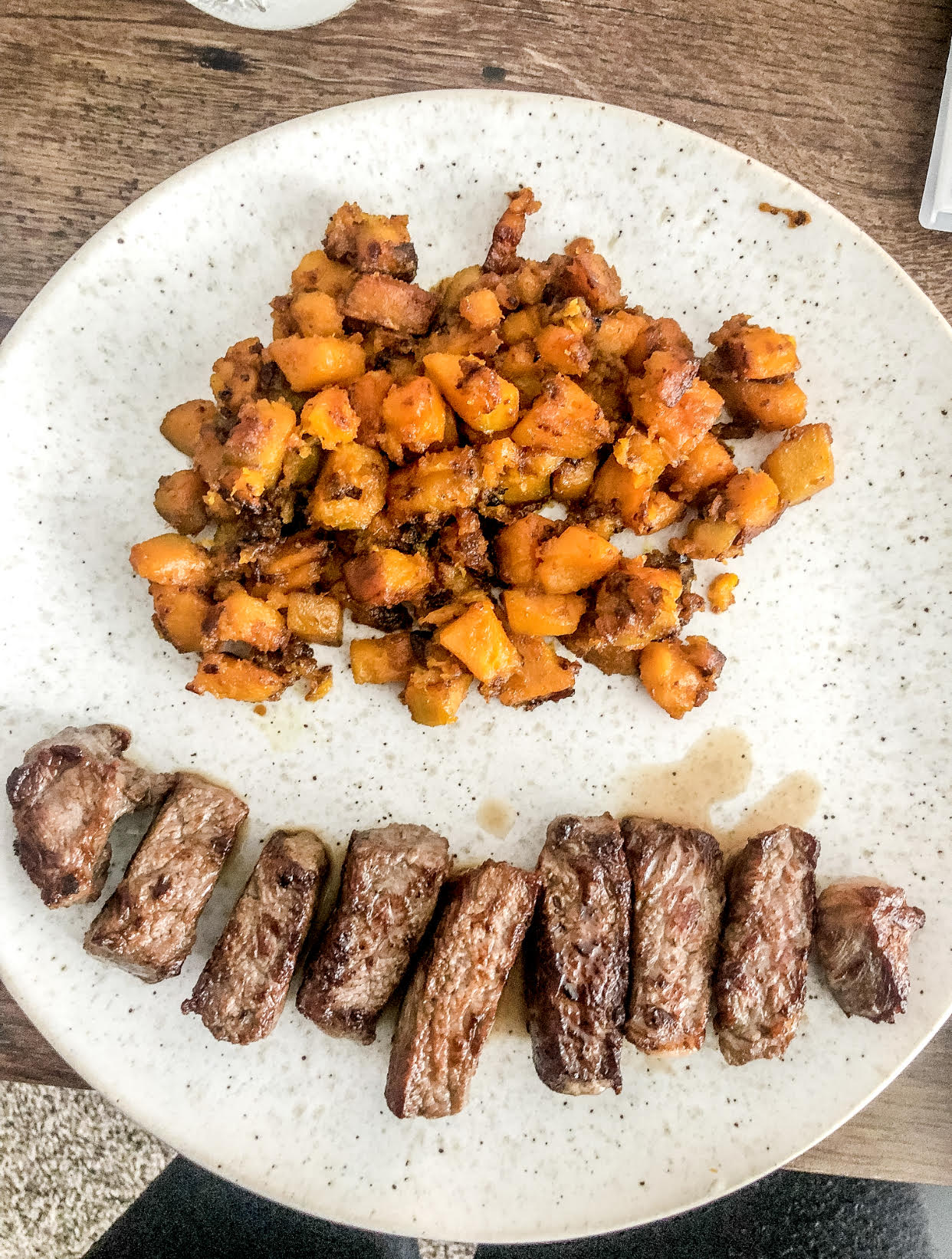
During my second trimester, I still needed a lot of food and to eat frequently, but I no longer had the intense cravings like I did during my first trimester and was able to get back to my pre-pregnancy foods.
I did some research on pregnancy diet philosophies and was drawn to two – The Brewer Pregnancy Diet and the Weston A. Price Diet for Pregnant and Nursing Mothers. I took what resonated from each and made my own template.
- Brewer Pregnancy Diet: I included all sections except for grains, calcium replacements, and green vegetables. For milk products, I drank raw milk (32 oz+/day). For the protein section, I ate meat and raw cheese. And for the other sections, I chose animal-based fruits (usually strawberries, oranges, and squash). I occasionally ate sweet potatoes too.
- Weston A. Price Diet for Pregnant and Nursing Mothers: I didn’t take cod liver oil (the notice at the bottom of the page freaked me out), but I followed the list of recommended foods almost to a T. I went back and forth between collagen and bone broth as bone broth sometimes upsets my stomach. I ate ghee instead of butter and I didn’t do coconut oil.
- Note: Real Food for Pregnancy by Lily Nichols and The Nourishing Traditions Book of Baby & Child Care by Sally Fallon Morell & Thomas S. Cowan are also great pregnancy diet resources.
My goal during my second trimester was to consume the below foods/fluids daily at a minimum:
Fluids:
Food:
- 1/2 lb+ meat (I tried to eat as much beef as possible)
- 3 tbsp ghee or avocado/guac
- 2 egg yolks
- 1 cup+ fruit (usually oranges or strawberries)
- 2 Medjool dates
- 1.5-2 oz beef liver every other day
- 3-4 oz+ raw cheese
- 1/2 cup squash or sweet potatoes
- Collagen or bone broth intermittently
My goal was 80-100g+ of protein per day. animal based pregnancy
Why just egg yolks?
Some days I just craved the yolks, and other days, I craved the whole egg.
While I don’t have any crazy reactions to egg yolks or whites, I think my stomach does better with the yolks only. It’s subtle, but I feel it.
And to my knowledge, the yolks are more nutrient-dense compared to the whites.
During pregnancy, I didn’t experience an aversion to eggs per se, but I rarely craved them or felt like eating them.
But eggs are an important food to eat during pregnancy. Both the Weston A. Price Diet for Pregnant and Nursing Mothers and The Brewer Pregnancy Diet recommend 2+ per day, and Weston A. Price recommends even more yolks. On the days I’m blah about eggs (which is most days), I find it easier to just shoot down the yolks. animal based pregnancy
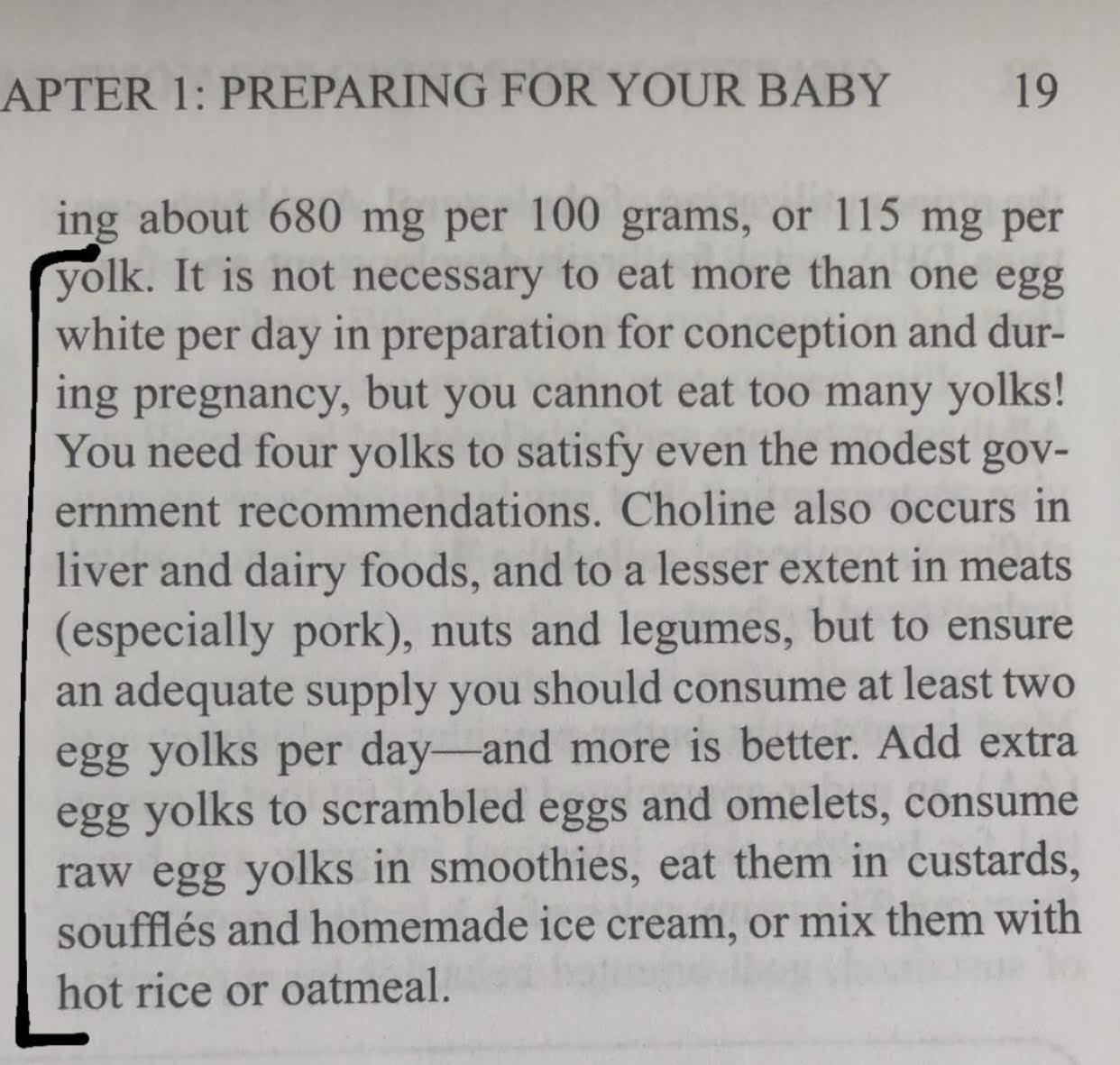
Excerpt from The Nourishing Traditions Book of Baby & Child Care by Sally Fallon Morell and Thomas S. Cowan, MD
Supplements
Because my diet was back on track, I minimized the amount of supplements I took in my second trimester for two reasons:
- To save money.
- Because I felt confident in the nutrition I was getting through my diet.
I eliminated Bone and Marrow, Living Bone, Beef Liver, Beef Tallow, and Pure Radiance C as I was eating bone broth, collagen, tallow, ghee, and tons of raw dairy, liver, and fruit again.
I added probiotics to help prep for the GBS test (which I later declined, ha). Since I wasn’t eating a ton of fermented foods (they often hurt my stomach), I figured the probiotics would help regulate the GBS bacteria if I had an overgrowth of some sort.
I added Blood Vitality for extra iron and kept the Wild Caught Fish Eggs since I wasn’t eating any fish as well as the desiccated oysters for an intermittent nutrient boost. I also continued with the D/K2 drops because I wasn’t confident I was getting enough sun, and magnesium because it’s good for everything. animal based pregnancy
Here is a list of my second trimester supplement routine:
- Wild Caught Fish Eggs (3 capsules/day)
- Blood Vitality (3 capsules/day; I started this at 24 weeks)
- Magnesium Breakthrough (2 capsules/day with my evening meal)
- Probiotics (1 capsule/day; I started this at 24 weeks)
- Desiccated Oysters (2 capsules/day intermittently)
- D/K2 drops (6 drops/day)
If I could do it all over again, I’d probably:
- keep BiOptimizers Magnesium Breakthrough, Desiccated Oysters, Ancestral Supplements Wild Caught Fish Eggs, and D/K2 drops
- eliminate the Probiotics
- replace Ancestral Supplements Blood Vitality with Heart & Soil’s prenatal stack (Beef Organs, Firestarter, Lifeblood, Mood, Memory & Brain)
Note: If you’re looking for an organ supplement source that is cheaper than Heart & Soil but still high quality, consider Perfect Supplements. They offer a multi-organ blend and a desiccated liver supplement. You won’t get the targeted support that you do with Heart & Soil, but these are great alternatives. Perfect Supplements also offers both products in bulk powders. Use ASHLEYR for 10% off at checkout.
If you end up purchasing any of the above-mentioned products, you can use my discount codes to save money.
For Heart & Soil: ASH10 for 10% off.
For Marine Health Foods Desiccated Oysters: ASHLEYR for 10% off.
For BiOptimizers Magnesium Breakthrough: ASH10 for 10% off.
Tests
Anatomy Scan
At around 20 weeks pregnant, I opted to get the anatomy scan done. This was a comprehensive ultrasound and took about 45 minutes. I’m not sure if I would do this again considering the consequences of ultrasound technology, but it was a cool thing to experience this time around.
We got to watch our baby move on the screen and see her developing organs. The tech took a bunch of photos and sent them to a physician to be reviewed for any potential genetic and/or structural abnormalities or deformities.
We also opted to find out the gender at this appointment.* animal based pregnancy

Gestational Diabetes Test
In regards to the gestational diabetes test, I never planned on drinking the Glucola drink. Instead, my plan was to eat a carb-heavy, sugar-heavy breakfast (probably eggs, cassava flour pancakes, dates, orange juice, maple syrup and/or honey – something like that) then go into the lab and take the blood test.
A week or so before I planned to do the test, that option didn’t feel good to me for some reason. I talked to my midwife about what else I could do, and she said that instead of going to the lab, I could use a glucose monitor to track my blood sugar after the meal. That sounded better, so I decided to do that.
I looked for a glucose monitor online, but the reviews for the ones I found were garbage. Many reviewers claimed they experienced false high or inconsistent readings. This made me feel uneasy and fearful that I’d get an incorrect reading and be wrongly pathologized.
Looking back now, nothing about the test itself really felt right for me. I wore a CGM for 2 weeks pre-pregnancy and discovered that I actually sat on the low end of blood sugar and needed more food and fruit to bring up/stabilize my blood sugar. Once I did that, my sugars were steady eddy and I felt great. (Check out my CGM IG story highlight here to learn more about that.)
Plus, my midwife told me that if I did end up having gestational diabetes, we would probably just keep my diet the same and continue to monitor my sugars.
Due to my understanding of metabolic health and because I felt confident in my diet, I just never felt like I needed the test. The conditioned “what ifs” haunted me in the back of my mind, however, making me feel indecisive.
Around the time I was making the decision, I listened to this podcast. It mirrored how I was feeling about the test and empowered me to go with my gut.
In the end, I declined the test altogether. It just never felt right.
I didn’t take any other tests during my second trimester. animal based pregnancy
*Gender Reflections
My husband and I were both leaning toward wanting a boy. You should have seen our faces in the ultrasound room when we found out we were having a girl. 🙂
My husband adjusted quickly and became joyous almost immediately. I kicked, screamed, and cried for about 24 hours. I had a hard time calling the baby “she.” I was angry, upset, and experienced very confusing/powerful/haunting thoughts and emotions (I think this was due to the realization that I will be the same sex parent/role model, my current insecurities and fears, plus some old childhood wounds)…until I talked to an old friend who helped me radically shift my perspective.
After this chat, I grew more and more excited to parent a little girl. My husband asked me if I could wave a magic wand and change the gender to a boy, would I…and absolutely not! The thought of having a boy now makes me less excited than having a girl. Amazing how a perspective can feel so potent and unwavering, but then change so fast.
Before I became pregnant, I always wanted a boy. I’m more masculine than feminine, and always felt like I’d know what to do with a little boy.
But the entire pregnancy, I just knew I was having a girl. I can’t explain it other than a strong intution.
Early on (starting at about 6 weeks), I began to deeply question myself about what it means to be a woman. My femininity was constantly challenged and I found myself quite emotional about what was coming up. I suddenly (seemingly overnight) felt calls to have a softer touch, be more graceful, take care of myself better, rest more, slow down, do my hair, pamper myself, and all of the feminine things.
My default is to get shit done fast. I usually skip pampering and restful activities for the sake of achievement, and generally, I’m pretty aggressive, harsh, and rough by nature…so these calls to be softer challenged the hell out of me. So that was clue number 1 that it was a girl.
My mind kept saying, “I think it’s a boy,” but immediately my gut would follow with “nope, it’s a girl.” The gut voice felt deeper, more real, and more truthful. My mind was trying to convince me, but my gut knew.
Also, when my husband and I talked about names, we liked a million girls names but literally zero boy names. Once day, I scrolled through a list of 1000 boy names and didn’t feel drawn to any. I told my husband, “if it’s a boy, I don’t think we’ll ever find a name.” This also made me wonder if we were having a girl.
The morning of the ultrasound, I posted a photo on my Instagram stories of my meal. It said “baby fuel,” and when I typed that out, it autocorrected to “baby girl.” Little silly tidbit, but I felt the universe telling me something then.
And when I was getting dressed for the ultrasound, I held up two underwear – blue and pink – and my gut said, “wear pink, it’s a girl.” I hate being wrong so I chickened out and wore purple (ha), but I just knew it was a girl.
And what do ya know…it ended up being a girl! I had to move through some things to get here, but as I write this, I couldn’t be more excited to be having a little girl. animal based pregnancy

Fetal Movement
I felt my daughter’s first movements around 17-18 weeks. Paying attention to how fetal movement changed throughout my pregnancy was fascinating.
Based on what I understand of fetal movement, the more the better…within reason. When the fetus is moving, they’re “exercising” in a way…building their nervous system, muscles, joints, and tissues. Intuitively, this made me think that the more my baby girl moved, the more energy she had, which meant she was getting what she needed.
When I drank salt water, raw milk, and ate raw cheese/fruit/beef liver, she was super active. When she moved, it’s like she was saying “thanks mom.”
The more stressed I was, the less I felt her. The more relaxed I was, the more I felt her. My inputs seemed to be directly related to her needs, and it felt like she was telling me how she was doing through movement. The better I was managing myself, the more she seemed to move.
I visualize the concept in this way…an undernourished, depressed person who has trouble leaving the couch vs. a nourished, energized person who propels themselves to go on a run. They way you move (or don’t) says a lot about your state of being.
All this is not to say that when your baby isn’t moving, something is wrong. Periods of stillness are normal and necessary to maintain balance. This goes for both growing fetuses and adult humans. But how you move does say a lot. animal based pregnancy
Minimizing toxic products
I am adding this section at about 17.5 months postpartum as I think it’s important. I wasn’t super mindful of this while I was pregnant, but over the past year or so, we’ve worked hard to eliminate all toxic products in our home. Minimizing toxic exposure is very important for fertility and pregnancy. I have product guides available now that I created to help people source nutrient-dense food and replace conventional products with lower-toxic alternatives. Check them out here, if interested.
Other
I think diet and nutrition play a large role in preventing stretch marks, but to cover all bases, I treated myself to a jar of this belly butter. I started using it around 24 weeks, applied it once daily (usually post-shower in the evening), and felt like a goddess whenever I lathered myself up with it. Ingredients are few and clean. I used it on my boobs and belly.
I also ate 2+ Medjool dates per day to help soften my cervix. Cool side note…during sex while pregnant, I can actually feel how much softer my vagina/cervix is compared to pre-pregnancy. I always wonder if it is due to the dates! animal based pregnancy
I’m obsessed with salt.
Find out why here.
Third Trimester (28 weeks – birth)

34 weeks
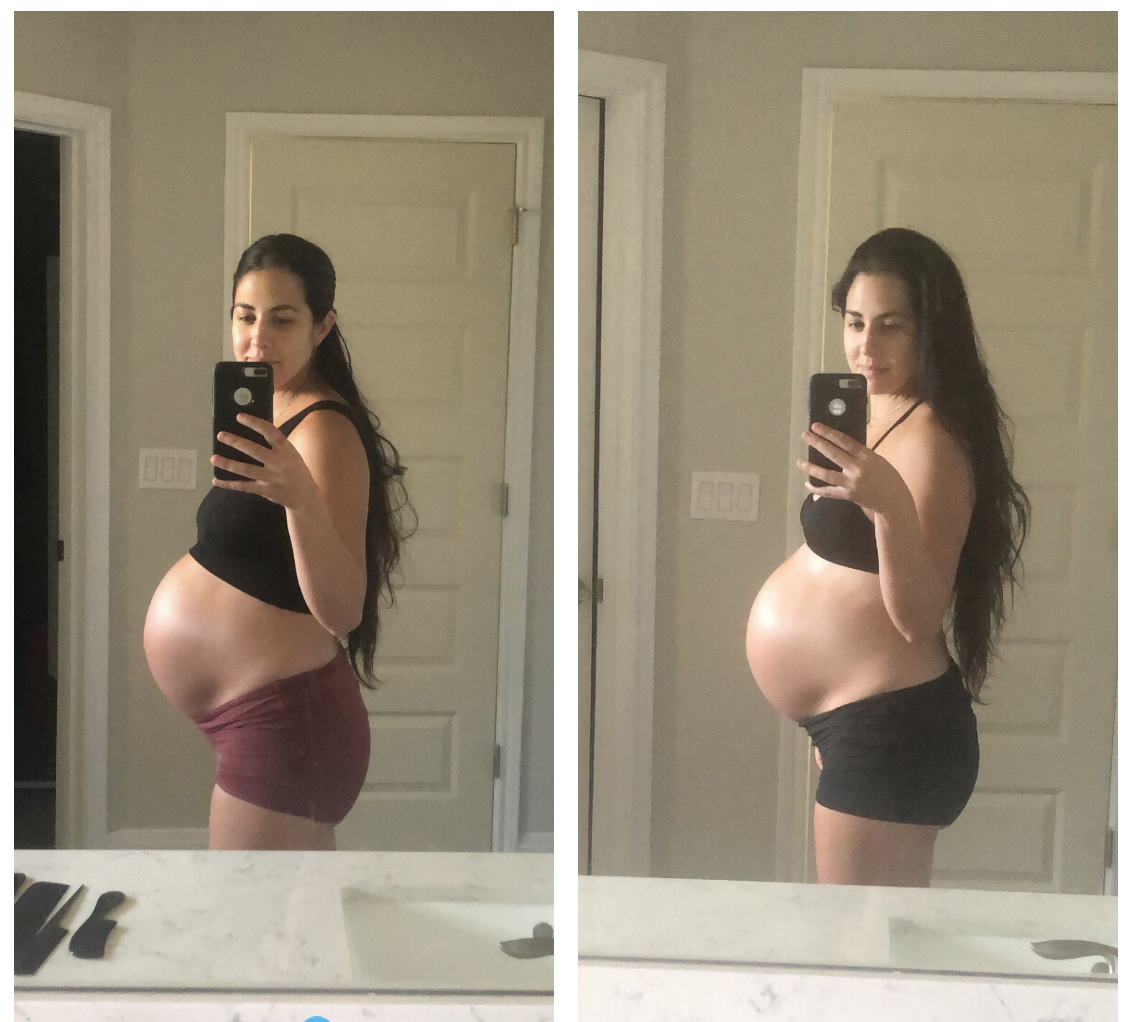
37 weeks vs. 38 weeks. The photo on the right is 3 days before I went into labor!
Diet
My third trimester diet was pretty close to my second trimester diet, however I made some slight modifications (upped the amount of egg yolks + decreased the amount of ghee).
I also tried to eat as much as I could. This was challenging as there was less room in my abdomen, so I found grazing throughout the day to be best.
I couldn’t stomach a lot of animal fat (like ghee) so I backed off from this. To replace it, I ate avocado occasionally and upped my raw cheese consumption.
All I craved during my third trimester was raw dairy and fruit. Meat and eggs were really hard to eat. I usually had to force them down.
Hard-boiling eggs and slurping down the yolks worked well. For meat, I usually had to dress it up in bowls with other fruit (like bananas and kabocha squash), hide it in cassava flour quesadillas with raw cheese, or add condiments or something else to make it pleasurable to eat.
I have four story highlights on my Instagram page (Pregnancy, Pregnancy 2, Pregnancy 3, Pregnancy 4). Check them out to see the meals I ate while pregnant throughout all trimesters. animal based pregnancy
My goal during my third trimester was to consume the below listed foods daily at a minimum:
Fluids:
- 32oz+ raw milk
- 64oz+ salted water
- 8-16oz+ red raspberry leaf tea
Food:
- 1/2lb+ meat (I tried to eat as much beef as possible)
- Avocado/guac 1-2x per week
- 3-4 egg yolks
- 1 cup+ fruit (usually oranges or strawberries, sometimes apples and bananas)
- 2 Medjool dates
- 1.5-2oz beef liver every other day
- 4-8oz+ raw cheese
- 1/2 cup squash or sweet potatoes (I ate squash and sweet potatoes more in my second trimester than my third; In my third, I ate them a few times per week)
- Collagen or bone broth intermittently
Supplements
My third trimester supplement routine was similar to my second trimester routine, but I added red raspberry leaf tea (helps tone the uterus) and alfalfa (helps prevent postpartum hemorrhaging). animal based pregnancy
I hear amazing things about red raspberry leaf tea. Many women claim to have faster/easier labors after loading up on this stuff in the weeks and/or months leading up to their due date.
Below is how I like to drink my red raspberry leaf tea. I found it super refreshing, especially during the warmer months. I did this in the morning so my drink was cold by the afternoon.
- Get a 32 oz mason jar.
- Fill it up with how many cups you’re looking to drink for that day (i.e. 16 oz for 2 cups).
- Pour the water into a tea kettle and bring it to a boil.
- Pour the water back into the mason jar once boiled, add one tea bag per cup of water (i.e. 2 tea bags for 2 cups) and steep for 15-20 minutes.
- Remove the tea bags once the tea is done steeping and allow it to sit on the counter for 1-2 hours to cool.
- Once it’s around room temperature, place it in the fridge so it gets really cold, usually for a couple of hours.
- Add the juice of 1/2 lemon per every 2 cups of tea. Add honey if you want it sweeter. I personally preferred it without the honey.
I initially tried to up the Wild Caught Fish Eggs and Blood Vitality to a full dose of 6 capsules each, but my stomach didn’t like the large capsule load and my body felt fine continuing with the half dose.
Here is a list of my third trimester supplement routine:
- Wild Caught Fish Eggs (3 capsules/day)
- Blood Vitality (3 capsules/day)
- Magnesium Breakthrough (2 capsules/day with my evening meal)
- Probiotics (1 capsule/day)
- Desiccated Oysters (2 capsules/day intermittently)
- D/K2 drops (6 drops/day)
- Red raspberry leaf tea (1-2 cups/day)
- Alfalfa* (2 capsules/day)
*I like this one because the dose is only two capsules twice daily. The dosing for most alfalfa supplements is nuts…like 3 capsules 5 times per day. animal based pregnancy
If I could do it all over again, I’d probably:
- keep BiOptimizers Magnesium Breakthrough, Desiccated Oysters, Ancestral Supplements Wild Caught Fish Eggs, and D/K2 drops
- eliminate the Probiotics and Alfalfa supplement
- replace Ancestral Supplements Blood Vitality with Heart & Soil’s prenatal stack (Beef Organs, Firestarter, Lifeblood, Mood, Memory & Brain)
Note: If you’re looking for an organ supplement source that is cheaper than Heart & Soil but still high quality, consider Perfect Supplements. They offer a multi-organ blend and a desiccated liver supplement. You won’t get the targeted support that you do with Heart & Soil, but these are great alternatives. Perfect Supplements also offers both products in bulk powders. Use ASHLEYR for 10% off at checkout.
If you end up purchasing any of the above-mentioned products, you can use my discount codes to save money.
For Heart & Soil: ASH10 for 10% off.
For Marine Health Foods Desiccated Oysters: ASHLEYR for 10% off.
For BiOptimizers Magnesium Breakthrough: ASH10 for 10% off.
Grazing
Around 34-35 weeks, it became hard to eat large meals. I felt the room inside my abdomen decrease more and more as the days went on. Sometimes more than just a few bites of food felt like too much.
Coming from 2 large meals per day pre-pregnancy, even after almost 9 months, this was still a challenging adjustment for me. My stomach thrives while fasting and doesn’t love a constant influx of food.
This was another part of pregnancy where I was forced to surrender to feel as well as possible. The way I saw it, these little things I resisted (yet needed to do to feel well) helped me practice surrendering resistance.
This is a great graphic that shows how little room your organs have near the end of pregnancy. Check out the stomach at 36 weeks!
Tests
I got one blood test (CBC + Rh+ antibody test) done in my third trimester. I was mainly curious to see if my diet and supplementation held up in place of taking a conventional prenatal.
My hemoglobin was 12.3 (compared to 13.5 in my first trimester) and my hematocrit was 36.4 (compared to 37.9 in my first trimester). Both figures didn’t change much, which I was very happy about.
Next time, I’d probably do a CBC again in my third trimester to check my hemoglobin/hematocrit levels, but pass on the Rh+ antibody test.
I was scheduled to have another CBC late in my third trimester and to get the GBS test, but I declined both.
Because I felt confident with my hemoglobin/hematocrit numbers going into my third trimester, I didn’t feel like an additional test was necessary. I initially planned to take the GBS test, but like the gestational diabetes test, I started to have second thoughts about it. This podcast empowered me to go with my gut and decline it. animal based pregnancy
Minimizing toxic products
I am adding this section at about 17.5 months postpartum as I think it’s important. I wasn’t super mindful of this while I was pregnant, but over the past year or so, we’ve worked hard to eliminate all toxic products in our home. Minimizing toxic exposure is very important for fertility and pregnancy. I have product guides available now that I created to help people source nutrient-dense food and replace conventional products with lower-toxic alternatives. Check them out here, if interested.
Other
Once I ran out of the belly butter, I started using this coconut oil I had on hand. I didn’t love it as much as the belly butter, but it did the job. I still don’t have any stretch marks.
Early in my third trimester, I got some urine dip sticks and tested myself every two weeks or so.
They give you lots of info…nitrites/leukocytes (possible UTI/infection), protein (possible pre-eclampsia), glucose (possible gestational diabetes), specific gravity (possible dehydration), urobilinogen/bilirubin (liver function).
I wasn’t too concerned about these things, but it was cool to be able to test myself at home for reassurance.
I also got a blood pressure cuff and tested my blood pressure at home instead of at my midwife appointments. Because I tend to have higher readings around providers, testing at home felt way better for me.
I continued with the 2+ Medjool dates per day to help soften my cervix.
I also got out in the sun as much as possible (especially to get sun on my belly as I heard the benefits can transfer to baby) during my third trimester too. I had to be cautious with sun time though. If I overdid it, I became exhausted and dehydrated quickly and it sometimes led to fatigue and insomnia. animal based pregnancy
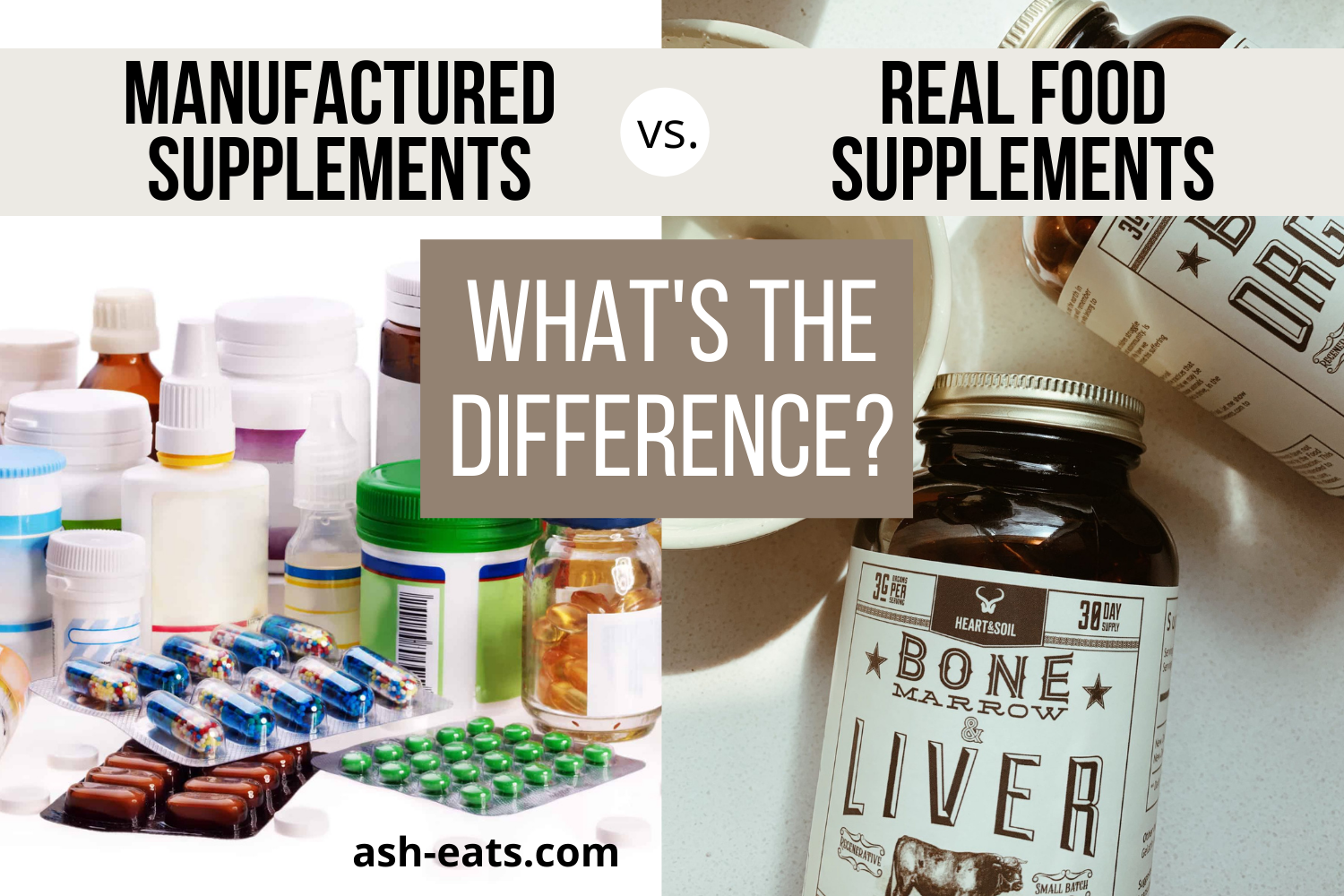
Want to learn more about my full real food supplement routine (and why you may want to consider ditching your manufactured supplements)?
Read this post here to learn more.
Labor Prep (36 weeks – birth)
I haven’t gotten here yet, but this is my plan:
- Increase red raspberry leaf tea consumption to 3-4 cups/day at 36 weeks.*
- Start taking evening primrose oil orally at 37 weeks.**
- Start inserting evening primrose oil vaginally at 38 weeks.**
- Continue with eating 2+ Medjool dates per day.
- I have heard good things about this 5W supplement. I don’t plan on taking it, but I wanted to mention it here for you to consider/research yourself in case it resonates.
*At 36 weeks, I upped my red raspberry leaf consumption to 3 cups per day. During weeks 34-37, I had a massive fear of going into preterm labor. Not totally sure where it came from as I’ve had a great pregnancy without any risks or complications, but it really messed with my head. At the end of week 35, a stressful event occurred. During weeks 35-36, I started to get more contractions than usual. While the contractions could have been caused by other things like stress or dehydration, I learned that for some women, the red raspberry leaf tea can bring them on too. I had a scary experience one night during week 36 (oddly enough, the day before this experience, I accidentally left my tea steeping for 1.5 hours – oof) with contractions that came every 5-10 minutes for hours. It happened immediately post-sex, so the contractions made sense, but the experience really got to me (I thought I was going into preterm labor) so I stopped taking the red raspberry leaf tea. Within a day or two, I was barely getting contractions and felt better overall. My stress also leveled out, so that could have played a role too. I started up with the red raspberry leaf tea again at 37.5 weeks. I’m currently 38 weeks as I write this and haven’t had any problems or overwhelming contractions yet. I’m drinking 2 cups per day right now.
**I decided against taking the evening primrose oil both orally and vaginally. Not for any particular reason…my gut just told me no. Some women swear by it though, so that’s something to keep in mind.
Natural remedies for pregnancy ailments
The body – especially the pregnant body – is complex and individual. The ailments listed in this section can have multiple causes/complicated roots. What I share here is by no means comprehensive. I’m just sharing what I noticed to be true of my experience and what worked for me.
Nausea in the first trimester
Check out this post for more about nausea in the first trimester.
Pregnancy constipation/hemorrhoids
Check out this post to learn how I resolved my painful pregnancy constipation/hemorrhoids.
Insomnia
When I experienced insomnia, I noticed one of the following things usually caused it:
- eating spicy or acidic food (almost any spice, nightshades, or acidic fruits like orange, lemon, lime gave me bad acid reflux and hindered my sleep)
- lack of magnesium (read more about that here and here)
- not drinking enough salt water/electrolyte water throughout the day (read more about that here and here)
- eating too much food throughout the day without hydrating properly or eating too close to bed
- high stress (a “salt water rally” resolved this most of the time – check out my IG highlight “Pregnancy 3” to learn more about what a “salt water rally” is)
- overdoing sun time
Feeling winded/out of breath
Feeling winded/out of breath can be a normal part of pregnancy, but for me, when I was under-fed, under-salted, and/or under-hydrated, the problem became way worse. Drinking a large glass of salt water or eating a nutrient-dense snack often helped with this.
And more importantly, “staying ahead of myself” (a concept I wrote about in this post) when it came to nourishment seemed to mostly prevent me from getting winded. If I ate regular snacks and drank lots of salted water (especially when it was hot or humid outside), this kept me feeling good, energized, and feeling like my circulatory/respiratory system was working properly. animal based pregnancy
Emotional fluctuations
Being emotional is part of pregnancy, but when I experienced extreme emotional fluctuations, I found that it was usually due to:
- being overworked/needing rest
- low salt
- improper hydration
- needing to let go of something
- high stress/unexpected event unfolding before me
A combination of rest, a “salt water rally,” and release through a good cry almost always resolved the intense emotional storm for me. Check out my IG highlight “Pregnancy 3” to learn more about what a “salt water rally” is. animal based pregnancy
Sciatica
When I got flare-ups of sciatica, they appeared to be directly related to constipation. Once I got my constipation under control (read more about that here), the sciatica flare ups went away.
UTI
I have had lifelong problems with bladder infections and UTIs.
During my pregnancy, whenever I felt like a UTI was coming on (or when my pee strips showed I had leukocytes in my urine), I took this D-Mannose supplement. After a few doses, the symptoms went away (sometimes within hours).
Update: I now recommend this one as it’s sourced from birch and is corn-free.
Since UTIs are common in pregnant women, some days I would take a dose or two randomly as a preventative.
I have been taking D-Mannose for about 7 years and it’s worked like a charm. I haven’t been to a doctor or needed any medications/interventions for UTIs since I found it. Read more about D-Mannose and how it works here. animal based pregnancy
Peeing a bunch of times
Sometimes I felt like I was attacked by my bladder. Other times, I felt like my bladder was normal. Some nights I would pee 2-3 times. Other nights I felt like I peed 100 times.
I noticed that the days I was hydrating erratically (i.e. getting behind and chugging water to catch up) were the days I also felt attacked by my bladder.
Also, my body absorbs salt/electrolyte water better than unsalted water, so if I drank too much unsalted water, this diluted my electrolytes and threw things off too.
(If large amounts of salt scare you, read the Brewer Pregnancy Diet philosophy on salt here.)
To regulate this problem, it helped me to imagine a steady stream of nourishment throughout the day. Moderate amounts of both food and water in consistent intervals. Too much, too little, and any sort of inconsistency seemed to throw my body out of whack. When I hydrated properly and consistently, my bladder (and the rest of my body) felt way more optimal.
I also felt better when I did the bulk of my hydrating in the first half of the day. If I didn’t hydrate in the morning, I’d feel straining/tension in my bladder, like it was too empty and didn’t have what it needed to work properly. Then if I drank too much at night to “catch up,” I would be up every hour or two peeing. animal based pregnancy
Preventing hot flashes throughout the night
Sometimes I was just hot throughout the night…especially when springtime rolled around here in Texas and the humidity was high. But if I hydrated well throughout the day with salted water, I found that I was able to regulate my temperature a bit better throughout the night.
Braxton-Hicks/Uterine activity
I felt Braxton-Hicks throughout the majority of my second and third trimesters. Peeing, pooping, walks, high heat/humidity, and being on my feet were the things that brought them on.
They were also more common in the morning. I think this had to do with fasting overnight. Once I got food and fluids in me, it seemed to help.
They felt like mild period cramps in my lower abdomen or like I needed to go diarrhea. They’d last for a minute or two, or sometimes longer if I was not in a state of rest (like walking or cooking, for example).
I hear they’re a normal part of pregnancy as the uterus is toning and getting ready for labor, but I found that the more I rested, hydrated with salted water, and continued to take my magnesium, the less frequent and strong they were.
Cold feet with bluish toes
I think this was a circulation/blood volume issue. I usually needed food, salted water, or to get up and move.
Swelling
I didn’t experience much swelling throughout my pregnancy, but as soon as springtime rolled around in Texas, the heat and humidity rose. If I spent time outdoors when it was hot and humid out, I would swell.
To some degree, it was inevitable. But when I knew I was going to be outdoors in the heat, adequately preparing for it by drinking tons of salt water ahead of time and eating regular snacks would minimize how much I swelled.
Check out the Brewer Pregnancy Diet philosophy on swelling here.
Once again, “staying ahead of myself” (a concept I wrote about in this post) was key throughout my entire pregnancy. If I stayed ahead of nourishment (food + hydration), my symptoms almost always remained minimal…including swelling.
Other
The book Home Birth On Your Own Terms is an amazing resource for healing pregnancy ailments at home with herbs and other natural methods. I also suggest reading the side tabs on The Brewer Pregnancy Diet website.animal based pregnancy
Want to learn more about oral magnesium vs. transdermal magnesium, the pros and cons of both, and how to figure out which method is for you?
Read this post here to learn more.
Books I highly recommend for pregnancy, labor, birth, and motherhood
There is nothing like a good book that speaks to a part of you that needs nourishing or growth at exactly the right moment. Many of the below books were just that for me during my pregnancy. Reading them transformed me in a way that I did not know I needed.
I particularly enjoyed Spirit Babies, Birthing from Within, Labor like a Goddess, and The Nourishing Traditions Book of Baby and Child Care, but all of the below books helped me with my pregnancy (and helped me prepare for labor, birth, and motherhood) in one way or another.
- Spirit Babies by Walter Makichen
- Labor Like A Goddess by Alexandria Moran & Lauren Mahana
- Become the God so She Can Labor Like A Goddess (for partners) by Alexandria Moran & Lauren Mahana
- Birthing from Within by Pam England & Rob Horowitz
- The Nourishing Traditions Book of Baby & Child Care by Sally Fallon Morell and Thomas S. Cowan, MD
- Anti-D Explained by Dr. Sara Wickham
- The Fourth Trimester by Kimberly Ann Johnson
- Home Birth on Your Own Terms by Heather Baker
- The Birth Partner by Penny Simkin & Katie Rohs
- Real Food for Pregnancy by Lily Nichols
Recommendations for yoga, hypnosis, and meditation
Doing moderate/high intensity exercise did not work for me during my pregnancy. I tried a number of times and almost always felt like it depleted me more than it helped.
Instead, I leaned on walks and yoga for movement and hypnosis and meditation to balance/calm my mind. I linked some of my favorite yoga, meditation, and hypnosis sessions/practitioners below. Some are pregnancy- and birth-specific. Others are not.
A note on practicing:
Early in my pregnancy, I heard a story that stuck with me. A woman was asked about her challenges during labor, to which she responded that leading up to her labor, she thought she did everything she could to prepare – meditation, yoga, keeping a calm and clear mind, etc. But when things turned during her labor, she realized that the prep work she had been doing was when she was in a good head space…not one that challenged her. So it no longer felt relevant or useful.
Throughout my pregnancy, I have felt great. So almost of my meditations, HypnoBirthing, yoga sessions, etc. have been done when I felt good. This isn’t a bad thing, but it’s not where the hard work lies, and from what I understand, it’s not an accurate simulation of labor. Being able to sit through a meditation when you’re not being challenged is not even close to the same thing as being able to bring yourself out of a challenging mental space using a tool like meditation. This idea helped me see that it’s a practice, not just an activity, and practicing when things are hard is where the skill is developed and mastered.
When I heard this woman’s story, I decided that while I would continue to practice when things were good, I would also use the moments where I felt bad – maybe a sensation I resisted in my body, an emotion that scared me, or an unpleasant thought my mind was stuck on – to practice bringing myself out of a challenging head space and into a state of calm. When I started practicing this and realized how hard it is to do, it humbled the hell out of me and made me appreciate the mental game of labor and the challenging unknown that’s ahead. Just some food for thought.
Yoga
- Boho Beautiful Prenatal Yoga for All Trimesters
- Boho Beautiful Gentle Prenatal Workout
- Boho Beautiful Gentle Prenatal Morning Yoga
- Yoga with Kassandra Prenatal Yin Yoga
Meditation & Hypnosis
- HypnoBirthing Program (The Mongan Method). Note: I enjoyed the book and the meditations (I purchased this package), but since there were only a few meditations, it got boring and repetitive for me. I switched to the GentleBirth Hypnobirthing app (below) and have been enjoying it.
- GentleBirth HypnoBirthing App
- The Honest Guys Meditations
- The Mindful Movement Meditations
- Silva Method Meditation
Fetal Positioning Exercises
My doula recommended the following fetal positioning exercises to me.
Initially, I found the options useful, but overwhelming (since there was so many), so I just took what resonated. There’s a part of me that wanted to write a long, comprehensive list of every exercise that applied to me and tyrannically force myself to adhere to that list every single day, and another part that said, “just do what you feel like doing.” As I get father along in my pregnancy, I’ve been listening to the latter part.
The movements I choose are based on how I feel and what I think my body needs that day. During my final weeks of pregnancy, I’ve been moving every day, walking a lot, holding deep squats, bouncing and doing hip rotations on my birth ball, and other stretches to try to open up my hips.
Things I didn’t do, but other women swear by
Tons of women reached out to share/recommend the things that helped them with their pregnancies. I included some of them below.
I haven’t personally tried them, but I received the recommendations enough times to feel that they were worth mentioning here (in case they resonate with you).
- Pregnancy Chiropractor. Every woman that reached out to recommend a pregnancy chiropractor swears by their pregnancy chiropractor. I’ve heard stories of pregnancy chiropractors helping with constipation, hemorrhoids, and pregnancy pain of all kinds.
- Pelvic Floor Physical Therapist. Just like the women who were enthusiastic about their chiropractic experiences, same went for women who used Pelvic Floor PT’s during their pregnancies. Midway through my second trimester, I had a mild leaking pee problem. I was considering going to a Pelvic Floor PT, but the problem seemed to resolve on its own, so I changed my mind. Pelvic Floor PTs usually do an internal exam (vaginally) and they assess how contracted or relaxed your muscles are. They will usually give you a tailored plan based on your unique situation/body and exercises to work on to help strengthen or relax associated muscles.
- Thompson Method for breastfeeding. If you have concerns or hesitations about breastfeeding, check out The Thompson Method here.
Useful Instagram accounts for pregnancy, labor, birth, and motherhood
The below accounts, for the most part, share information that aligns with my philosophies around pregnancy, labor, birth, and motherhood. During my pregnancy, it felt good to surround myself with energy and information that would empower me and not scare me.
Having a good birth team
Having a birth team that will empower you is extremely important. This is something I didn’t know until I knew, unfortunately.
When I moved to Texas, I googled “homebirth midwife in Austin, TX” and checked out the first website that came up. It looked good, so I called the midwife, asked her a few questions, and felt okay with what I heard.
When I got pregnant about 6 months later, I called her back and began care without much thought.
Throughout the duration of our relationship, I began to notice subtle things that made me uncomfortable. These things grew into major red flags. Around 30 weeks pregnant, I no longer felt comfortable with her assisting me during my birth so I transferred care.
From here, things got very messy and chaotic. I am now pursuing legal action against her and filing complaints with multiple regulatory bodies.
After talking to members of the Texas Midwifery Board and other local industry professionals about my experience, I learned that dozens of other women also experienced the same sort of things under her care (some stories being way more horrific than mine).
Apparently this has been happening for years. When I asked a local industry professional why this sort of thing was allowed to continue, her response was, “many women just think these things are normal so they never think to say anything.”
We are conditioned to trust, comply, and obey providers instead of following our own guts. And the worst providers use fear and manipulation to gain power and control, which is what this midwife did.
I share this story to say that if you’re having gut feelings or your intuition is pulling up red flags about your provider (or anything else in your pregnancy), listen to them. You’re probably not wrong.
I didn’t realize how much my original midwife’s energy was impacting me until I got another midwife who I felt entirely different around. During our first appointment together, I felt calm. Her energy was grounding and comforting. I left feeling so much more empowered and confident under her care, beaming with optimism about my birth and like everything was truly going to be okay.
After experiencing these euphoric feelings, I realized in hindsight that I never experienced anything close with my first midwife.
The tricky part? If I never experienced this refreshing energy with my new midwife, I probably would have normalized the fear, power trips, disassociation, defensiveness, and condescending energy my original midwife continuously put out…not seeing that there was a different way.
We don’t know what we don’t know. This is why I stress the importance of listening to your gut/intuition.
We may not know something initially, but if you listen to your intuition and allow it to guide you, it may bring you to a better place where you see something that you didn’t before.
I haven’t given birth yet, but this experience showed me how important it is to have trust in your birth team. Because I felt such a tangible difference in energy from each midwife while pregnant, I can’t even imagine the impact this energy difference would have had on me while in labor. I am so so so grateful I listened to my gut and changed providers prior to delivery.
This sounds cliché, but I mean it…when in doubt, go with your gut.
Feeling bloated? Read about the 10 things I did to beat the bloat for good.
Read this post here to learn more.
For Rh- mamas
I am O- and my husband is A+.
Since my husband’s dad is A- and his mom is B+, my husband holds one Rh- allele from his dad and one Rh+ allele from his mom. Since I am O-, I hold two Rh- alleles from both of my parents.
Given this info, my husband and I have a 50% chance of having an Rh+ baby.

If you would have asked me at the beginning of my pregnancy about the RhoGAM shot, I would have told you that if my daughter ends up being Rh-, I wouldn’t get it, and if she is Rh+, I will.
But as I looked into the shot, my hesitation grew. My mom gut told me something didn’t feel right about it.
I don’t love that it is a human blood product (sourced from thousands of donors) and that it comes with pathogenic risk. The thought of getting injected with the blood of thousands of human beings I don’t know really irks me. And considering the pandemic, donors could be vaccinated, but there is no way to tell for sure…another irk.
On the flip side, if I don’t get the shot, there is a risk of becoming sensitized to the Rh+ protein and harming future pregnancies.
Because both sides held what felt like extreme risk, my internal compass did not point strongly toward either.
I joined the Facebook group RhoGAM Rebellion and read personal accounts from moms.
The stories were all over the map.
Some got the shot, and…
- believe it saved their future pregnancies
- still became sensitized (even with both the pregnancy and post-birth shot)
- were injured from it
- believe it injured their children
Others didn’t get the shot, and…
- had a home birth with no interventions and still became sensitized/had problems with future pregnancies
- birthed plenty of Rh+ babies and never became sensitized or had any problems with future pregnancies
- birthed plenty of Rh+ babies, became sensitized, but never had any problems with future pregnancies
These stories didn’t clear things up right away, but they did demonstrate that the shot is not as effective as I once thought it was. So even if I got it, it may not work.
I also learned that some moms never got the shot, had no problems, and had plenty of healthy babies. So if I didn’t get it, maybe I’d be just fine.
The following podcast, books, and IG video gave me what I personally needed to make my decision. There is no alternative to getting the RhoGAM shot and it does not come without risk, but if you are on the fence like I was, I highly recommend checking out the below resources.
Podcast:
- Gestational Diabetes, GBS, Ultrasound Technology, and RH Negative: A New Perspective by The Free Birth Society
Books:
- The Nourishing Traditions Book of Baby & Child Care by Sally Fallon Morell and Thomas S. Cowan, MD
- Anti-D Explained by Dr. Sara Wickham
Instagram:
- IG video on RhoGAM by Holistic RN @lindseytuttlenp

Excerpt on RhoGAM from The Nourishing Traditions Book of Baby & Child Care book
I also highly recommend getting your partner’s blood type checked even if he thinks he knows it.
My husband’s mom told me she was 100% certain that he was B+. I ended up testing him anyway to be sure and he is actually A+.
This doesn’t change our Rh situation, but I’ve heard stories of hospitals telling moms their baby’s blood type only to find out years later that it was the wrong one, so you just never know.
I linked a cheap and popular blood type test you can get on Amazon below.
Final thoughts
I hope you found some of these thoughts, reflections, and suggestions useful.
I’m in the home stretch of my pregnancy now. It’s been a road with challenges, but I’ve learned so much about my body, femininity, and spirituality. I feel like I’ve grown so much in such a short period of time. The process of creating life (while being a conscious animal) is remarkable.
Best of luck to you with your pregnancy, labor, birth, and motherhood. animal based pregnancy
If you have any questions, do not hesitate to reach out to me at asheatsgood@gmail.com.
For more animal-based pregnancy, birth, postpartum, and motherhood resources, check out my Pregnancy hub. animal based pregnancy






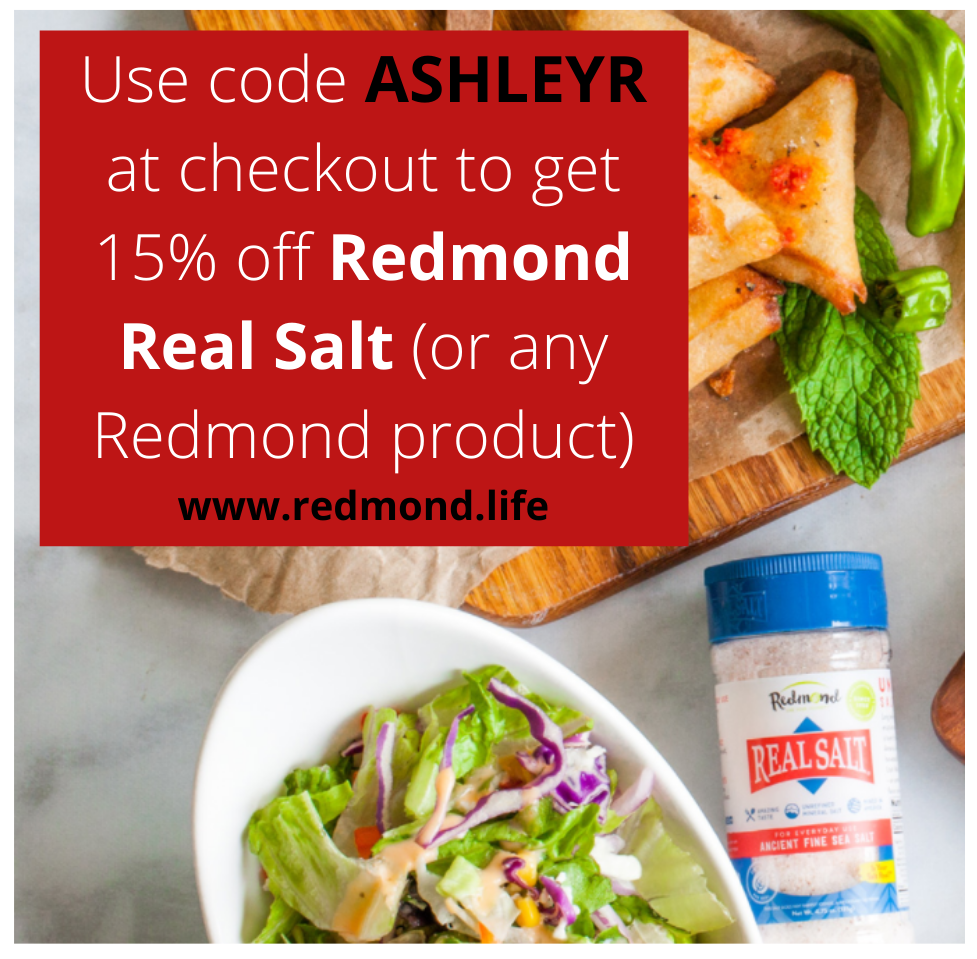
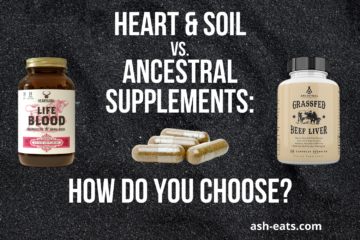



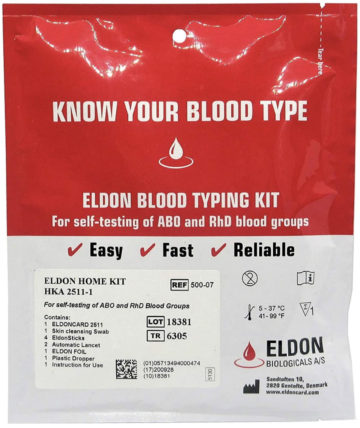


Thank you so much for sharing all this!! I just found out I’m pregnant with baby #4, and my prenatal experience with my 3rd was horrible. I’m listening to the Free Birth Society podcast you linked, and so much resonates with me, particularly the gestational diabetes and GBS stuff. I also appreciate you sharing your diet, because that’s something I’ve struggled with. I’m taking some Heart & Soil supplements, but the taste is horrible, so I don’t end up taking as many as I’d like.